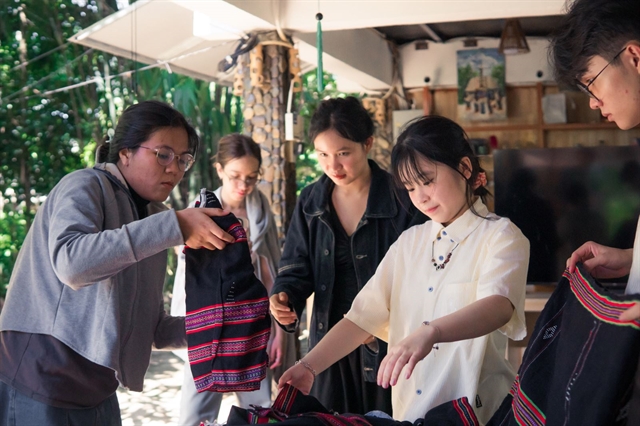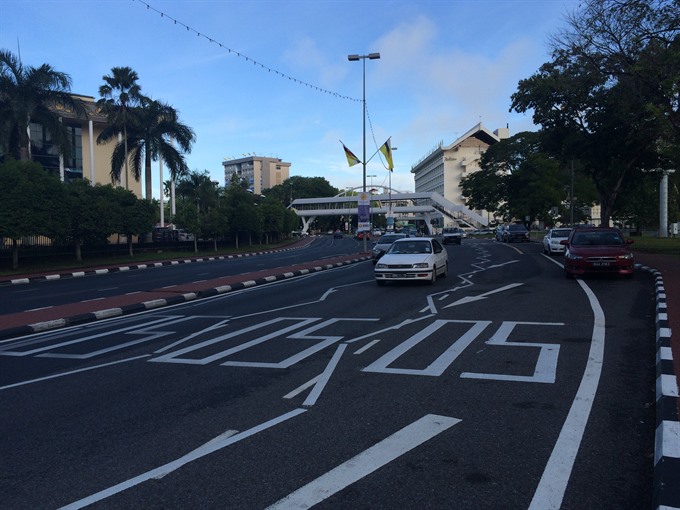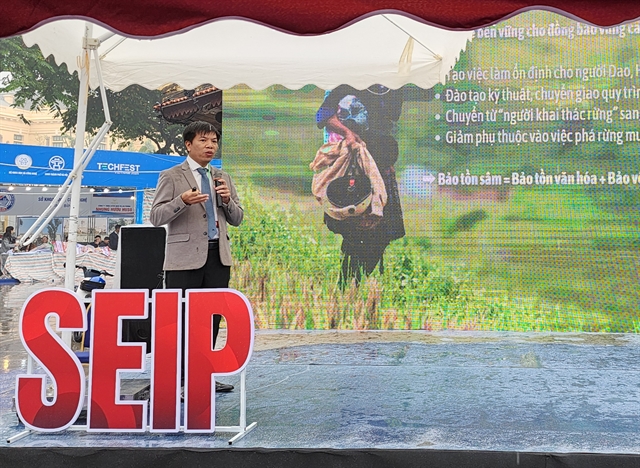 Features
Features

Brunei was not on my list until this year, when I was offered the opportunity to be a delegate for the Young South East Asian Leaders Initiative (YSEALI) programme on Eco-Entrepreneurship last month. It was a pleasant, and very green, getaway.
19494633AM.jpg) |
| Into the jungle: Crossing the river to start our trekking journey through the forest. |
I have always had a desire to travel around South East Asia before the age of 25, however, Brunei was not on my list until this year, when I was offered the opportunity to be a delegate for the Young South East Asian Leaders Initiative (YSEALI) programme on Eco-Entrepreneurship last month.
Brunei, according to my research before the trip, did not have much going for it in terms of tourism. I was proved wrong, and enjoyed a pleasant, and very green, getaway.
Touching down in Badar Seri Bagawan, the capital of Brunei Darussalam on a rainy afternoon, I was startled by the city’s abundant greenery. Clean streets were bordered by rows of trees, and the road from the airport to the hotel reminded me of Singapore. However, Brunei lacks the sky trains and skyscrapers of Singapore. One of my Bruneian friends told me that in Brunei, houses must be kept under the height of the local mosques, following the strict Islamic faith of the country. I was tired of high rises blocking out the sun in metropolises, so I quickly fell in love with Brunei.
My Bruneian friend, Khalish, kindly drove me around Badar Seri Bagawan to enjoy the night life. It takes only 20-30 minutes to drive around the small capital, which covers an area of just 100sq.km. With the windows down, we enjoyed breathing the fresh air while passing pristine forests, a well-earned reprieve from the noise and pollution of Hà Nội. Sixty per cent of the country is covered by forest, and it was easy to get close to nature, even in the city.
Not surprisingly in this Muslim country, night life is not as vibrant as some of the other big cities in South East Asia. Bars, pubs, and karaoke are banned, and beer and wine are not on sale to the public. Stores, shopping malls, and other services all close before 10pm. Therefore watching TV or going to sleep are what Bruneians do after dark, according to Khalish.
Not wanting to retire to my hotel before 10pm, I decided to visit Gangdong night market, which thankfully stays open until 11pm. Markets are a good way to acquaint oneself with city life because they truly reflect local livelihoods and lifestyles. Due to the late hour, there were not many visitors, but you could still find BBQ food, drinks, clothes, and in particular, loads of fresh fruit and vegetables. The market is simple, and similar to the way Bruneians live.
85894605AM.jpg) |
| Food of the forest: Welcome snacks at Sumbiling Eco Village, including fried flour mixed with eggs and shrimp, and egg rice wrapped in eco-friendly leaves. |
The excitement of eco-tourism
My surprise at how the country preserves the environment and respects nature continued when I took a one-day tour to a rural area located in the district of Temburong, one among Brunei’s four districts, besides the capital city. Temburong is home to Ulu Temburong National Park, the country’s first national park. The park is known as the “Green Jewel of Brunei” and described as “the finest example of the sultanate’s successful forest protection policy”.
We strolled along the capital’s streets to reach Kianggeh jetty for a speedboat ride along mangrove-fringed waterways. On the 40-minute cruise passing the Malaysian border, we saw a lot of stilt houses that make up Kampong Ayer water village, the historic home to for almost 40,000, ten per cent of Brunei’s total population. Surprisingly, it is the largest traditional water village in the world. It took another 40 minutes by car to reach our final destination: Sumbiling Eco Village.
Far from the capital, Sumbiling Eco Village is a rural space where visitors can feel deeply at one with nature.
About eight years ago, Leslie Chiang Jin Kiong, the founder of the village, imagined a location where travellers could enjoy an experience closer to nature, and in a manner consistent with local ways of life. At that time, in his mind he considered one thing, “I want something people want, not what I want.”
“They (local people) do not want money, they want respect,” he said.
That is the reason why at the same time, the village provides Iban villagers with the means to earn an income while bringing new value to environmental conservation. To date, the village supports 15 family members by providing them with job opportunities as trekking guides, boatmen, and craftswomen, as well as sponsoring two school students for their school fees, uniforms, and books.
 |
| Clean roads: A tidy street in Badar Seri Bagawan. VNS Photos Khánh Dương |
Eco-tourism is familiar to me because of explanations and examples in books and on social platforms. However, not until my visit to Sumbiling village, listening to its owner, and engaging myself in activities, did I really have a concrete idea about how eco-entrepreneurship works. I’m still enchanted by the eco-village slogan printed on staff T-shirts: “Farming is cool, smart, sexy and humane”.
If you’d love to relax inside wooden huts surrounded by greenery, the weaving and stone painting activities with locals may be an ideal suggestion. You could also while away the hours on a hammock by the river, and soak in the tranquility of the forest. If you are curious about how home-grown food is cooked, you can help make some bamboo chicken, surely the signature dish of an eco-friendly lunch. The chicken is stuffed into bamboo shoots and roasted on an open fire. After being cooked the chicken is soft, and maintains the pleasant smell of bamboo leaves.
My adventurous streak urged me to take on a more challenging activity: trekking into the rainforest to really soak in its majesty and preserved beauty. For this, we took a 2-minute boat ride across the river to reach the starting point of our journey. The route, at first, was easily accessible, except for some steep slopes. We were guided by two kind English-speaking locals, an older one and a younger one. The guides were incredibly knowledgeable, and we were able to learn about unique flora and fauna on the trail, how villagers would hunt in the past, and how the various leaves and roots could be put to use.
There are thousands of herbs you can find in the pristine rainforest. I was introduced to a type of leaf called kulimpapa, which had a pleasant and fresh odour. The young guide told me that this particular plant could be used to treat stomachache or other digestive ailments. It is also soothing for skin irritations caused by allergies or insect bites.
Many other plants can be used for a range of common illnesses and conditions. I was excited to discover the origin of some organic cosmetics. My lipsticks I use every day, for example, are made from palm fruits containing vitamin-rich oil.
On the challenging way back, we faced thorny plants, slippery puddles, and I felt exhausted after seven kilometres of tough trekking, however, my mind was revitalised after being surrounded by fresh air and herbs.
Whether spending time in the city or kicking back in the countryside, for me the memory of Brunei is a green and refreshing one. VNS




